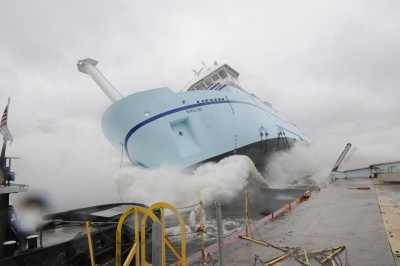Arctic marine research has suffered over the past decades because the U.S. academic fleet, operated by the University-National Oceanographic Laboratory System (UNOLS), has never operated an ice capable vessel. This has not been the case for the Southern Ocean, which always has had both supply and research capabilities. Nor was it the fault of enthusiastic scientists. For example, Dr. Robert Elsner, now emeritus professor with the University of Alaska Fairbanks (UAF), has pursued this dream since the 1970s. He kept a log of all ice-capable vessels in the world, was familiar on a first hand basis with Finnish icebreaker technology, and wrote early proposals for the design of a U.S. arctic research vessel. He had become familiar with The Glosten Associates of Seattle, the naval architect firm that subsequently worked with UAF and the UNOLS design committee over the years.
Over the next decades we carried out three design efforts with support from the National Science Foundation. The first was completed in the 1970s but funding was never secured. The second met a similar fate more than a decade later. The final and successful effort resulted in a far more capable vessel than earlier designs. During my tenure as Director of the Institute of Marine Sciences and Dean of the UAF School of Fisheries and Ocean Sciences, it was high priority for me to work on the proposals and design and to keep the project visible in Washington, D.C. Dr. Thomas Royer, Chairman of the UAF ship committee, played an important leadership and design role for the project as well. In the end it was the American Recovery and Reinvestment Act of 2009, also known as the "Stimulus Act," that provided the funds for construction. Making use of this opportunity was possible because the ship design was ready at the right time and because the National Science Foundation made it a priority.
Now, as the vessel is approaching the "sail away" day, it is impossible for me to mention all the talent, devotion, and support being provided by the University of Alaska team, the Wisconsin shipyard team at Marinette Marine Corporation, and the National Science Foundation. Construction and launch of the R/V Sikuliaq is a dream come true. Bob Elsner and I were honored as ship sponsors with our initials engraved on the keel and participation in the christening and launch. The latter was amazing! About 2,000 people stood outdoors in the wind and rain and cold—horrible weather—to watch the event. The launch itself was dramatic. The vessel slid sideways into the water (more like dumped) and almost keeled over before righting itself. A great roar of applause went up from the crowd.
The R/V Sikuliaq will be ready for operations in Alaskan waters in 2014. This is an extremely capable vessel. She is ice-worthy and well equipped for the scientific work ahead. The crew is being hired and sea trials will take place over the next few months. The Sikuliaq will be home-ported in Seward but will spend most of the time at sea.
— Vera Alexander
President, ARCUS Board of Directors
Further information about the vessel and program are available on the UAF School of Fisheries and Ocean Sciences website.

